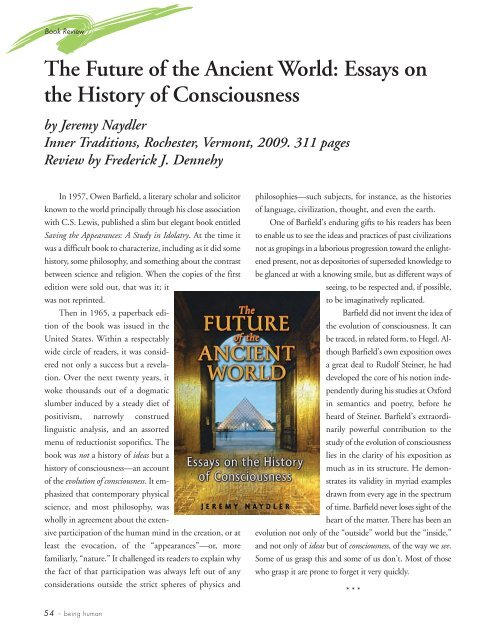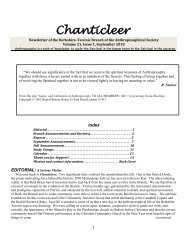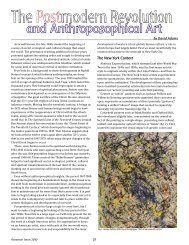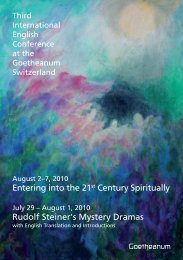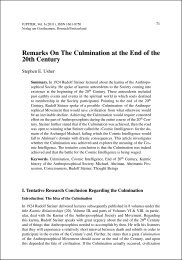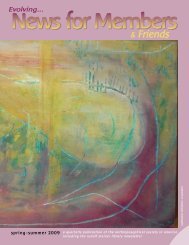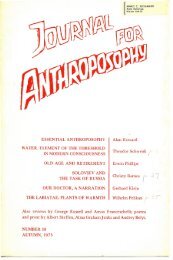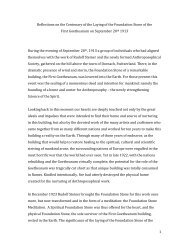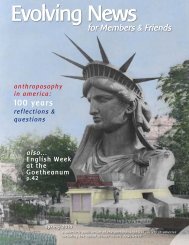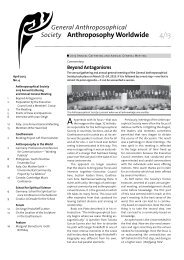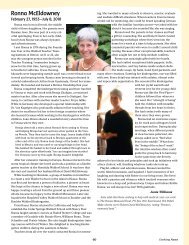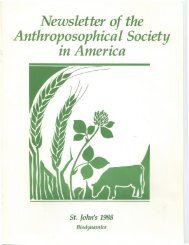Rudolf Steiner's Vision for the Future - Anthroposophical Society in ...
Rudolf Steiner's Vision for the Future - Anthroposophical Society in ...
Rudolf Steiner's Vision for the Future - Anthroposophical Society in ...
You also want an ePaper? Increase the reach of your titles
YUMPU automatically turns print PDFs into web optimized ePapers that Google loves.
Book Review<br />
The <strong>Future</strong> of <strong>the</strong> Ancient World: Essays on<br />
<strong>the</strong> History of Consciousness<br />
by Jeremy Naydler<br />
Inner Traditions, Rochester, Vermont, 2009. 311 pages<br />
Review by Frederick J. Dennehy<br />
In 1957, Owen Barfield, a literary scholar and solicitor<br />
known to <strong>the</strong> world pr<strong>in</strong>cipally through his close association<br />
with C.S. Lewis, published a slim but elegant book entitled<br />
Sav<strong>in</strong>g <strong>the</strong> Appearances: A Study <strong>in</strong> Idolatry. At <strong>the</strong> time it<br />
was a difficult book to characterize, <strong>in</strong>clud<strong>in</strong>g as it did some<br />
history, some philosophy, and someth<strong>in</strong>g about <strong>the</strong> contrast<br />
between science and religion. When <strong>the</strong> copies of <strong>the</strong> first<br />
edition were sold out, that was it; it<br />
was not repr<strong>in</strong>ted.<br />
Then <strong>in</strong> 1965, a paperback edition<br />
of <strong>the</strong> book was issued <strong>in</strong> <strong>the</strong><br />
United States. With<strong>in</strong> a respectably<br />
wide circle of readers, it was considered<br />
not only a success but a revelation.<br />
Over <strong>the</strong> next twenty years, it<br />
woke thousands out of a dogmatic<br />
slumber <strong>in</strong>duced by a steady diet of<br />
positivism, narrowly construed<br />
l<strong>in</strong>guistic analysis, and an assorted<br />
menu of reductionist soporifics. The<br />
book was not a history of ideas but a<br />
history of consciousness—an account<br />
of <strong>the</strong> evolution of consciousness. It emphasized<br />
that contemporary physical<br />
science, and most philosophy, was<br />
wholly <strong>in</strong> agreement about <strong>the</strong> extensive<br />
participation of <strong>the</strong> human m<strong>in</strong>d <strong>in</strong> <strong>the</strong> creation, or at<br />
least <strong>the</strong> evocation, of <strong>the</strong> “appearances”—or, more<br />
familiarly, “nature.” It challenged its readers to expla<strong>in</strong> why<br />
<strong>the</strong> fact of that participation was always left out of any<br />
considerations outside <strong>the</strong> strict spheres of physics and<br />
54 • be<strong>in</strong>g human<br />
philosophies—such subjects, <strong>for</strong> <strong>in</strong>stance, as <strong>the</strong> histories<br />
of language, civilization, thought, and even <strong>the</strong> earth.<br />
One of Barfield’s endur<strong>in</strong>g gifts to his readers has been<br />
to enable us to see <strong>the</strong> ideas and practices of past civilizations<br />
not as grop<strong>in</strong>gs <strong>in</strong> a laborious progression toward <strong>the</strong> enlightened<br />
present, not as depositories of superseded knowledge to<br />
be glanced at with a know<strong>in</strong>g smile, but as different ways of<br />
see<strong>in</strong>g, to be respected and, if possible,<br />
to be imag<strong>in</strong>atively replicated.<br />
Barfield did not <strong>in</strong>vent <strong>the</strong> idea of<br />
<strong>the</strong> evolution of consciousness. It can<br />
be traced, <strong>in</strong> related <strong>for</strong>m, to Hegel. Although<br />
Barfield’s own exposition owes<br />
a great deal to <strong>Rudolf</strong> Ste<strong>in</strong>er, he had<br />
developed <strong>the</strong> core of his notion <strong>in</strong>dependently<br />
dur<strong>in</strong>g his studies at Ox<strong>for</strong>d<br />
<strong>in</strong> semantics and poetry, be<strong>for</strong>e he<br />
heard of Ste<strong>in</strong>er. Barfield’s extraord<strong>in</strong>arily<br />
powerful contribution to <strong>the</strong><br />
study of <strong>the</strong> evolution of consciousness<br />
lies <strong>in</strong> <strong>the</strong> clarity of his exposition as<br />
much as <strong>in</strong> its structure. He demonstrates<br />
its validity <strong>in</strong> myriad examples<br />
drawn from every age <strong>in</strong> <strong>the</strong> spectrum<br />
of time. Barfield never loses sight of <strong>the</strong><br />
heart of <strong>the</strong> matter. There has been an<br />
evolution not only of <strong>the</strong> “outside” world but <strong>the</strong> “<strong>in</strong>side,”<br />
and not only of ideas but of consciousness, of <strong>the</strong> way we see.<br />
Some of us grasp this and some of us don’t. Most of those<br />
who grasp it are prone to <strong>for</strong>get it very quickly.<br />
* * *


